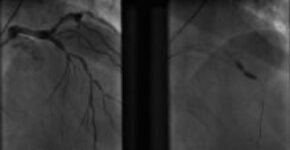Original title: Outcomes After Coronary Computed Tomography Angiography in the Emergency Department. A Systematic Review and Meta-Analysis of Randomized, Controlled Trials. Reference: Edward Hulten et al. J Am Coll Cardiol 2013. Article in press Chest pain is the second most common cause for visiting an emergency department. In all consultations, only few are finally acute coronary syndromes, for…
Ischemic preconditioning reduces infarct size in patients treated with primary angioplasty
Original title: Preinfarction Angina Reduces Infarct Size in ST-Elevation Myocardial Infarction Treated With Percutaneous Coronary Intervention Reference: Ronald Reiter et al. Circ Cardiovasc Interv. 2013;6:00-00. Ischemic preconditioning (IPC) is a phenomenon whereby transitory ischemia episodes protect the myocardium against a more prolonged episode. Until now, IPC has been the most effective approach to protect the myocardium. Pre infarction…
The FFR improves outcomes in daily practice as in randomized studies
Original title: Long-term outcomes of fractional flow reserve-guided vs. angiography-guided percutaneous coronary intervention in contemporary practice. Reference: Li J et al. Eur Heart J. 2013; Epub ahead of print Precision of the fractional flow reserve (FFR) to estimate the functional compromise of coronary stenosis and its ability to reduce events to decide PTCA, based on their outcome has…
The radial artery is the default access for Europe.
Original title: Consensus document on the radial approach in percutaneous cardiovascular interventions: position paper by the European Association of Percutaneous Cardiovascular Interventions and Working Groups on Acute Cardiac Care and Thrombosis of the European Society of Cardiology. Reference: Martial Hamon et al. EuroIntervention 2013; 8-online publish-ahead-of-print January 2013. The European Society of Cardiology (ESC) recently published a consensus…
Modest correlation between IVUS and FFR in intermediate lesions assessment
Original title: FIRST: Fractional Flow Reserve and Intravascular Ultrasound Relationship Study Reference: Ron Waksman et al. J Am Coll Cardiol 2013. Article in Press For patients with angiographically assessed intermediate lesions such as stenosis between 40% and 80%, criteria that favor revascularization remains under debate. Fractional Flow Reserve (FFR) is considered the gold standard to assess intermediate lesions,…
Periprocedural stroke, unrelated to the access site?
Original title: Influence of access site choice on incidence of neurologic complications after percutaneous coronary intervention. Reference: Karim Ratib et al. Am Heart J 2012;0:1-8 Article in press. Neurological complications post coronary angioplasty (PCA) are sporadic but they are associated with eight times increased mortality. A transradial approach has multiple advantages over femoral but could theoretically have a…
Ambulatory Transradial Percutaneous Coronary Intervention
Original title: Ambulatory Transradial Percutaneous Coronary Intervention: A Safe, Effective, and Cost-Saving Strategy. Reference: Philippe Le Corvoisier et al. Catheterization and Cardiovascular Interventions 81:15–23 (2013). The number of PCI procedures has increased and for many interventional cardiology centers PC interventions entail significant resource consumption. Reducing post procedure hospital stay could reduce costs and optimize hospitalization resources. The safety…
Rotational atherectomy is only an interim strategy.
Original title: High-Speed Rotational Atherectomy Before Paclitaxel-Eluting Stent Implantation in Complex Calcified Coronary Lesions. The Randomized ROTAXUS (Rotational Atherectomy Prior to Taxus Stent Treatment for Complex Native Coronary Artery Disease) Trial. Reference: Mohamed Abdel-Wahab et al. J Am Coll Cardiol Intv 2013; article in press Heavily calcified lesions are difficult and may prevent the appropriate expansion of a…
Chronic Total Occlusions, challenging but very possible
Original title: Predictors of Reocclusion After Successful Drug-Eluting Stent–Supported Percutaneous Coronary Intervention of Chronic Total Occlusion. The Florence CTO PCI Registry. Reference: Renato Valenti et al. J Am Coll Cardiol 2013; article in press. Previous registry data have shown a reduction in mortality rates in patients with successful recanalization of a Chronic Total Occlusion (CTO) compared to patients…
Does the systematic use of clopidogrel reduce events prior to angioplasty?
Original title: Association of Clopidogrel Pretreatment with mortality, Cardiovascular events, and Major Bleeding among patients undergoing percutaneous coronary intervention. A systematic review and Mata-analysis. Reference: Anne Bellemain-Appaix, MD et al. for the ACTION group. The loading of clopidogrel before coronary angioplasty is an accepted practice by most clinical and interventional cardiologists but, nevertheless, it is only based on…
Revascularization reduces mortality in patients with high risk coronary artery disease based on multi-slice CT
Original title: All-cause mortality benefit of coronary revascularization vs. medical therapy in patients without known coronary artery disease undergoing coronary computed tomographic angiography: results from CONFIRM (Coronary CT Angiography EvaluatioN For Clinical Outcomes: An InteRnational Multicenter Registry) Reference: James K Min et al. European Heart Journal (2012) 33, 3088–3097 doi:10.1093/eurheartj/ehs315. Several large studies have shown revascularization reduces mortality…










